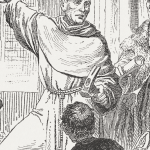Land of the Bible: Galilee and more
This series delves into the exploration of several significant locations in Galilee and the Golan Heights where Jesus walked, including major sites in the Jordan Valley such as Bet Shean. The journey culminates with visits to Ai, Shiloh, Gerizim, and Sychar in Samaria.
Ep. 1 Sea of Galilee Part 1 - The Kursi Church
At the heart of this Byzantine Monastery Church lies a captivating portrayal of the Life of Christ in Galilee - a profound and illuminating overview.
Ep. 2 Sea of Galilee Part 2 - Kursi 2 and Bethsaida
The first segment of this video focuses on the Miracle of the deliverance of the Demon-Possessed man in the tombs (Mark 5). The cliff to the south of here could be the place where the pigs ran into the sea.
The second segment moves to Bethsaida, but the first site is a gate that belonged to an unnamed city during OT times, possibly Geshur. The role of Absalom whose ancestors came from here is reviewed. Finally, there is an introduction to the later fishing village of Bethsaida. In ancient times the shore was much closer to the town.
The second segment moves to Bethsaida, but the first site is a gate that belonged to an unnamed city during OT times, possibly Geshur. The role of Absalom whose ancestors came from here is reviewed. Finally, there is an introduction to the later fishing village of Bethsaida. In ancient times the shore was much closer to the town.
Ep. 3 Sea of Galilee Part 3 - Bethsaida and Chorazin
The video explains the significance of the "Evangelical Triangle" of Bethsaida, Chorazin, and Bethsaida, and also features the fisherman's house. It provides an explanation of the only two-stage miracle performed by Jesus at Bethsaida (Mark 8), and mentions the Bethsaida Boys (Peter, Andrew, Philip), as well as offering a suggestion for why Peter left Bethsaida for Capernaum.
Ep. 4 Sea of Galilee Part 4 - Capernaum
The adopted home town of Jesus and headquarters of His Galilean ministry was one of the Big Three towns that heard and finally rejected Jesus’ ministry. The limestone synagogue built on an earlier basal synagogue recalls many incidents in Jesus’ ministry.
Ep. 5 Sea of Galilee Part 5 - Mt of Beatitudes and Tabgha
This video discusses the Mt of Beatitudes/Great Commission. Although not the exact site since the church is modern, it provides a scene in which to imagine the two events.
Ep. 6 Sea of Galilee Part 6 - Gennesaret and Maimonides
This video covers the First Century Boat at Gennesaret. A first century fishing boat found in the mud between the Kibbutz Ginnosar and Magdala is on the display in the Museum.
Maimonides’ Tomb in Tiberias. Tiberias was one of the 4 holy cities for Jews in the Middle Ages (in addition to Hebron, Jerusalem, and Shechem). The RAMBAM (Rabbi Moshe ben Maimon) was one of the greatest medieval Jewish scholars. He moved from Spain eventually to Egypt but requested to be buried in Tiberias.
Maimonides’ Tomb in Tiberias. Tiberias was one of the 4 holy cities for Jews in the Middle Ages (in addition to Hebron, Jerusalem, and Shechem). The RAMBAM (Rabbi Moshe ben Maimon) was one of the greatest medieval Jewish scholars. He moved from Spain eventually to Egypt but requested to be buried in Tiberias.
Ep. 7 Sea of Galilee Part 7 - Hamat Tiberias, Hippos/Susita, and the Boat Ride
The Byzantine period synagogue’s mosaic floor is a mixture of traditional Jewish symbols (the ark, the shofar, the incense shovel) alongside the signs of the Zodiac and the god Helios. Susita (Aramaic) or Hippos (Greek) for “horse” is the northern most of the Decapolis cities. Destroyed by a massive earthquake in 749AD, it was never rebuilt. An interesting example of a “city set on a hill” since it can be seen from every point around the Sea of Galilee.
Ep. 8 Gamla Part 1
Not visited by very many tour groups, the site has great historical drama and interest because of its role in the First Jewish Rebellion against Rome (66-73). Sometimes called the “Masada of the North” the Zealot stronghold held out until the eastern wall was breached. Inhabitants jumped from the western extremities to their deaths below.
Ep. 9 Gamla Part 2
In this video, remains of one of the few pre-70 synagogues and the ritual “mikvah” are examined.
Ep. 10 Quneitra
In this video, we visit the Golan Heights, including the Birkhat Ram, Druze villages, and the former Syrian fortifications prior to June 1967.
An interesting conversation with Israeli soldiers provides a contemporary aspect of the strategic nature of the area, facing the border with Syria.
An interesting conversation with Israeli soldiers provides a contemporary aspect of the strategic nature of the area, facing the border with Syria.
Ep. 11 Caesarea Philippi
Herod Philip renamed this site as Caesarea, replacing its earlier name of Paneas. The reason for this change was the worship of the god Pan, whose niches can still be seen in the rock cliff.
It was at this site that a great turning point in Jesus' ministry occurred. Here, Peter made his great confession (Matthew 16), and Jesus began to teach that he would suffer and die.
It was at this site that a great turning point in Jesus' ministry occurred. Here, Peter made his great confession (Matthew 16), and Jesus began to teach that he would suffer and die.
Ep. 12 Tel Dan Part 1
The historical site known as Dan 2 is believed to have been established after the migration of the Dan tribe from their original allotment near modern Tel Aviv, as recorded in Judges 17-18. After their conquest of Laish, the tribe set up an idol worship center at the site, where Jereboam later established his golden calf (as mentioned in 1 Kings 12). This site continued to be a significant religious center throughout the history of the northern kingdom, and even during Hellenistic times, it was identified as Dan through a Greek inscription.
The gate area is where the famous “House of David” inscription was found. Cultic installations at the gate illustrate the semi-pagan worship of the Israelites in this place.
The High place pagan cult area is then visited and we remember sadly the calves that were worshipped here from Jereboam onward.
The gate area is where the famous “House of David” inscription was found. Cultic installations at the gate illustrate the semi-pagan worship of the Israelites in this place.
The High place pagan cult area is then visited and we remember sadly the calves that were worshipped here from Jereboam onward.
Ep. 13 Tel Dan Part 2
Further explanation in the altar area is followed by an exploration of the Syrian trenches dug into the tel. Finally a visit to the Middle Bronze gate that may very well have been used by Abraham (Gen 12, 14).
Ep. 14 Beit She'an Part 1
Known as Scythopolis in Hellenistic times, Beit She'an was the only city of the Decapolis west of the Jordan. The extensive excavations are of that Greco-Roman city. The OT site of Beth Shean is on the high tel above this lower city. This is where the bodies of Saul and Jonathan were hung before they were taken away by the men of Jabesh-Gilead.
The huge theater, seating well over 4000, is the first place to visit. Most of the highest seats were stolen out to build the Arab town of Beisan.
The huge theater, seating well over 4000, is the first place to visit. Most of the highest seats were stolen out to build the Arab town of Beisan.
Ep. 15 Beit She'an Part 2
In this video there is a huge bathhouse with caldarium, tepidarium, and frigidarium with a palestra which looms large on the left of the huge street, which reaches to the foot of the tel.
Inside the shops is a beautiful mosaic floor with Tyche, goddess of the city. The rest of the site is marked by gigantic columns and capitals, some re-erected and some still lying where they were found when they fell during the 749 AD earthquake.
Other features of the lower city include temples and even a public latrine. South of the theater is the amphitheater where spectacles and combats were held.
Inside the shops is a beautiful mosaic floor with Tyche, goddess of the city. The rest of the site is marked by gigantic columns and capitals, some re-erected and some still lying where they were found when they fell during the 749 AD earthquake.
Other features of the lower city include temples and even a public latrine. South of the theater is the amphitheater where spectacles and combats were held.
Ep. 16 Ein Harod
Known as Gideon’s Spring, this site is as authentic as it can be. The scene of Judges 7 comes to life when Gideon reduced his army to meet the Midianites in the Valley of Jezreel to the north. Just above the spring is Mt Gilboa where Saul and his sons met their deaths (1 Sam 31).
Ep. 17 Biblical Ai
This video features a visit to an active archaeology dig with an explanation by one of the excavators. This could possibly be the very site of ancient Ai (Joshua 7-8).
Ep. 18 Shiloh Part 1
Shiloh is given the most detailed description of its location of any Biblical site. “Shiloh, which is north of Bethel, on the east of the highway that goes up from Bethel to Shechem, and south of Lebonah" (Jdg. 21:19). The tabernacle was here for almost 400 years. Here, 200 brides for 200 Benjaminite brothers were taken from their daughters (Jdg 21). Here young Samuel was bought after Hannah gave birth (2Sam 1) and here he grew up and was called by God (2 Sam 3). Shiloh was also where old Eli died when news of the defeat of Israel and capture of the ark arrived (2 Sam 4).
Ep. 19 Shiloh Part 2
According to Psalm 78:60 and Jeremiah 7:12-14, Shiloh was destroyed by the Philistines after they captured the ark. In the 19th century, an English explorer claimed that the flat area on the north of the tel was the original location of the tabernacle. The religious settlement that runs the archaeological site supports this identification, and Dr. Varner concurs with it. However, some scholars reject this identification because they don't believe that the tabernacle ever existed. Once we acknowledge its existence, the identification seems logical.
Ep. 20 Mount Gerizim Part 1
The mount of blessing, balanced by Mt Ebal to the north, was where Joshua renewed the covenant (Josh 8) and where the Torah’s blessings and curses were read (Deuteronomy 27-28).
The Samaritans view this as their holy mountain instead of Jerusalem. Here they offer the lambs in a colorful sacrifice each Passover.
The Samaritans view this as their holy mountain instead of Jerusalem. Here they offer the lambs in a colorful sacrifice each Passover.
Ep. 21 Mount Gerizim Part 2
The Samaritan Temple was destroyed by the Hasmonean John Hyrcanus 135 BC and was never rebuilt (see John 4). From the northern tip of Gerizim, Nablus (old Neapolis) can be seen as well as the crossing east west route and the north south route to the right. One can also see the church of Jacob’s Well and the OT site of Shechem.



